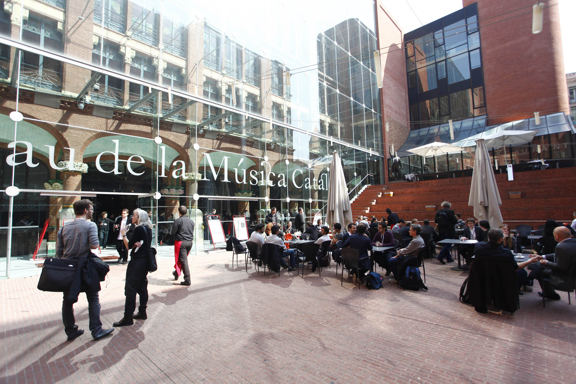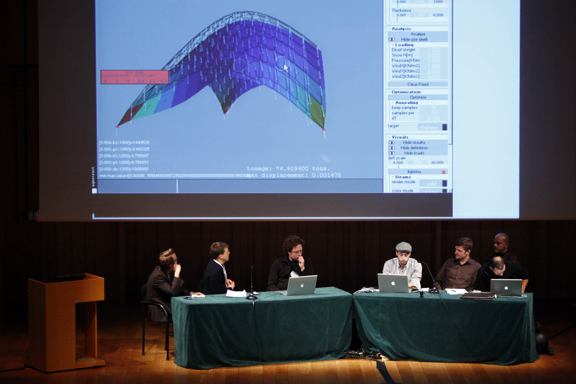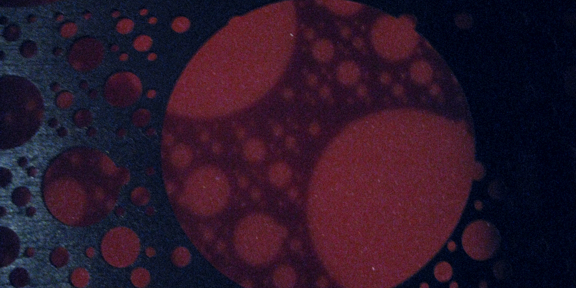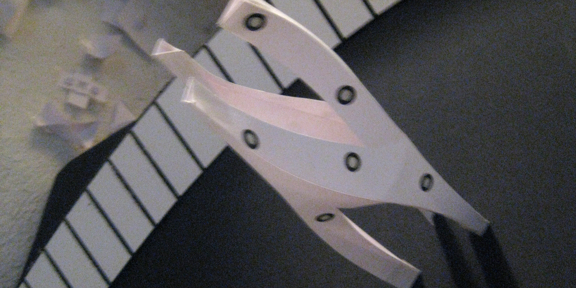March 25, 2010


Work and Play, both four-letter words, are often considered opposites. We dread one; we embrace the other. But at SmartGeometry workshops, work and play came together.
This year, in this annual event sponsored by Bentley Systems, some of the brightest minds in architecture, industrial design, engineering, and academia came together in Barcelona, Spain, in the shadow of Gaudi’s masterpieces. For four days, they retreated to the studio of the IAAC (Institute for Advanced Architecture of Catalonia), wrestling with wild ideas and tough metal. Divided into groups, they explored inflated fabrics, acoustic walls, manual construction methods, and rapid prototyping machines to figure out new ways to design, build, assembly, destroy, and rebuild.
On the fifth day, they emerged into sunlight (barely), to present their experiences at a public symposium at the Palau Musica Catalana (Catalan Concert Hall). Despite their blurry eyes and sleep-deprived nods, they exuded unbridled enthusiasm.
Would their creations—inflated canvass sculptures hanging from a wall, wood and metal assemblies composed of traditional and nontraditional geometry, and cardboard cutouts with varying geometric patterns—ever become practical goods or commercial products? Who knows? But the playful, defiant, experimental attitude cultivated here is bound to become part of how they work when they return to their respective vocational and academic disciplines.
Generative Iterations
In their experimental endeavors, workshop participants used digital tools to generate dozens of geometric variations (“form finding” is a common term among them), to find the most suitable form for their purpose. In Design for Destruction cluster (a subgroup exploring an idea), they used this method to identify a profile cutout with the lowest self-weight but highest loaded capacity. In Rapid R&D to Rapid Assembly cluster (subtitled “snap fit, push on”), they used a similar method to find blocks that could accommodate rapid, manual construction. In Parametric Acoustic Surfaces cluster, they used this method to identify basic wall patterns that provided best sound performance.
Many of them used Generative Components (GC), a computational design software from Bentley, to semi-automatically generate variations of geometric patterns. Though current deployment of GC in professional practices is often in architecture, nothing prevents consumer good designers, automotive designers, and engineers from using it.
Free Computational Design
On Thursday, Bentley announced it’s making GC available for free, as a standalone technology preview. (To download, visit the dedicated site www.Bentley.com/GetGC.) “The new offering provides a feature set solely focused on computational design and includes no-charge instructional materials and user support through a dedicated online GC forum,” the company said.
By releasing GC for free, Bentley hopes to benefit from user input. The software is currently used in conjunction with MicroStation, Bentley’s flagship product (and arguably AutoCAD’s primary competition) by professionals, but the free preview will place the software in the hands of many more students, enthusiasts, and researchers. Similar software programs include Grasshopper, a rhino plug-in, and Parama, a free download (Alpha code) available from Sourceforge.


Subscribe to our FREE magazine, FREE email newsletters or both!
About the Author
Kenneth Wong is Digital Engineering’s resident blogger and senior editor. Email him at [email protected] or share your thoughts on this article at digitaleng.news/facebook.
Follow DERelated Topics






